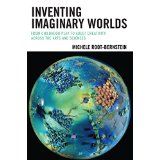
Play
The Creative Investment of Worldplay
Tomorrow's creative capital is today's creative play.
Posted December 2, 2014

How can parents, educators, business leaders and policy makers nurture creativity, prepare for inventiveness and stimulate innovation? One compelling answer, we suggest, lies in fostering the invention of imaginary worlds or paracosms, a.k.a. worldplay. Michele’s new book, Inventing Imaginary Worlds: From Childhood Play to Adult Creativity across the Arts and Sciences, lays out the argument. First emerging in middle childhood—and in some cases extending well into maturity—this complex form of make-believe draws lifelong energy from the fruitful combustions of play, imagination and creativity.
In this post and posts to follow, we’ll return to our explorations of all three of these fascinating subjects, with a special focus on worldplay. We first came to the topic as parents of a world-building child—from there, Michele made it her particular concern as a creativity scholar and writer. What do children get out of inventing imaginary worlds? What does society gain from their speculative experience? The more she learned about this complex play, the more we both became convinced of its importance for growing children, problem-exploring adults, and an innovating society.
So what is worldplay, anyway? In childhood and youth, imaginary world invention occurs as an outcome of the normally developing imagination. It is often associated, at least at first, with physical play in those secret, found and constructed places—like a closet under the stairs or a fort beneath the backyard bushes—that children find especially fascinating during grade school years. For some children, the play develops strong imaginary dimensions, even absent the closet or the fort. In the mind’s eye the imagined place is persistently and consistently recalled as a locus for play alone or with one or two intimate friends.
What makes worldplay complex is that it can accumulate narrative—the adventures, perhaps, of imaginary people. It can generate analogue systems of thought or activity—fictional animals and plants are organized into imagined ecologies, let’s say, or fantasy sports teams go round-robin for the championship. Over time (weeks, months, or years), worldplay evolves into an elaborate make-believe reality. And in many cases, the play provides impetus for the writing of stories and histories, the recording of statistics, the drawing of pictures and maps, or the building of other sorts of cultural artifacts that structure and sustain the play. In other words, worldplay can involve children in making things real as well as imagined—and in ways that boost creative capacity and potential. (See our post, Worldplay: One Cure for Imagination Deficit Disorder.)
What does this kind of play have to do with mature creativity? Plenty. Childhood worldplay is almost by definition a touchstone experience remembered for a lifetime. In Inventing Imaginary Worlds Michele traces quantitative connections between childhood play and adult endeavor in groups such as the MacArthur Fellows, selected for creative achievement. She also looks at qualitative connections articulated by individuals assessing the role of early play in their lives.
In the coming months, look for this personal evaluation of worldplay in Secret Country interviews and profiles, posted here and on Michele's worldplay website, inventingimaginaryworlds.com. What you’ll find is that, in many cases, the creative immersion of play repeats itself in the creative immersions of art or science or other exploratory activity. Whether in novels or video games that build upon fictions of people and place, or in humanistic scenarios that probe the past as well as the future, or in scientific experiments and hypotheses that posit alternate and possible realities, worldplay returns on early investment as creative inspiration, creative strategy, and creative capital at tomorrow’s ready.
See our next post: Secret Country Interview: Remembering Galway Kinnell
© 2014 Michele and Robert Root-Bernstein

